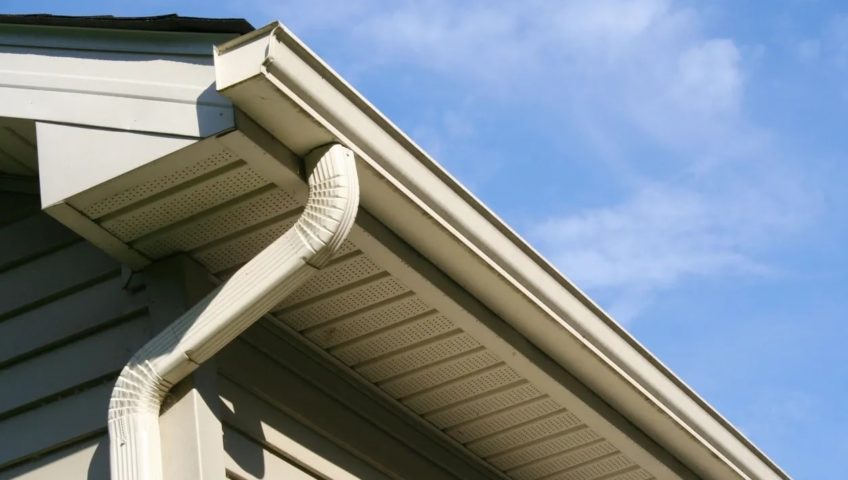While you may remember to clean your gutters or check them for clogs, most people forget to double-check their downspouts. For context, downspouts are the vertical pipes used to take the water collected by the gutters and carry the water away from the house. Because downspouts see so much volume, they can easily get clogged with leaves, twigs and other debris.
If you think your downspout is clogged, you first need to find and confirm the blockage.
How to Find a Downspout Clog?
If you’re noticing peeling paint or other signs of excessive moisture on the side of your home, your downspout is probably not transporting the water away from your home like its supposed to. To confirm your suspicions of a clog, take a screwdriver and tap the exterior of the downspout to listen for hollow spots. Remember, the entirety of the downspout should sound hollow, and if a spot doesn’t, then you’ve found your clog.
Other Signs of a Clogged Gutter
- The rainwater ran down the gutters, gathering in pools at its base before spilling over onto our driveway.
- The gutter is in full flood as water sprays out from seams and joints.
- The water doesn’t escape through the downspout extensions.
Look for these signs if it’s not raining outside:
- You notice the erosion of the ground below your gutter.
- The bottom of the gutter is wet or moist
- The gutter is pulling away from the fascia.
Common Places Where Gutters Get Clogged
Downspout Cage
The downspout cage, also known as a wire strainer designed to trap debris while allowing water through it is located where the gutter intersects with your roof. If you notice that this item seems out of place or bent then there could be an issue behind its appearance!
Gutter Hands and Spikes
When leaves and twigs are caught in the gutters, they can cause a clog. This is because Gutter Hangers or spikes slip loose from the fascia, landing next to it where there’s no protection against water damage, like at the edge of the roof line.
Downspout Elbows and Seams
The downspout is likely where you’ll find the source of your water flow problems. Working your way along its length, tap on either side with a screwdriver and listen for any dull thuds to indicate that there may be an issue here before going any further!
What Causes Clogged Downspouts?
Gutters are important to clear for downspouts not to be clogged. Debris from your gutters can flow into the pipes and cause blockages, which will result in water flowing back up towards you rather than away like it should do when everything is working correctly.
Some of the common causes for blocked downspouts include:
- A Ball – Tennis balls and baseballs are the perfect size to get trapped in your spout!
- Roof Shingle Sludge or Tar – The paste forms an adhesive with other organic materials that can ball together in your gutters.
- Pine Needles – The pine needle is actually an extremely effective natural remedy for clogged drains. Its small size makes it easy to pass through your drain, but when collected together in large numbers, they can form solid plugs that will stop any flow of waterway entirely!
- Leaves and Twigs – Leaves and twigs can be especially bad if your house is located deep in the woods.
How to Unclog a Downspout?
If you’re lucky, your downspout clog can be removed with a strong stream of water from your hose, however, there are times where that pressure won’t be enough to dislodge the blockage.
A plumbing snake can help remove more stubborn blockages, but wielding the snake on the top of your home can be risky, so at this point, you may need to call the professionals.
If a snake doesn’t work you should take downspouts off and clear out any clogs. Then rinse everything well, reassemble your gutter system properly and attach them back in their proper place.
Once you’ve called a gutter specialist to your home, they’ll examine the downspout and gutters to determine where the clog is and the best way to remove it. They will also need to double-check the gutter cage (the mesh material between the gutter and the downspout). The mesh cage can become full of debris, or the cage could be damaged if you recently experienced a storm. If your cage is causing the blockage, your professional gutter repairman will need to replace the cage to allow water to flow freely once again.
How to Prevent a Clogged Downspout?
Whether you just cleaned your gutter downspout from a clog or want to prevent downspout buildup, adding gutter guards will be your best bet at preventing any future clogs. Gutter guard installation can be tricky, so this is another task that’s best left to the professionals. Once you’ve hired your gutter experts, they’ll take specialized mesh to cover the gutters; the mesh will allow water to freely flow, but twigs and other debris won’t be caught in the stream of water, or in your gutters.
Need Help Cleaning Your Clogged Downspouts?
Do you think you have a clogged downspout? Give our gutter experts at New Vision Exterior Solutions a call today to schedule a consultation. We’ll be able to help you clear your clogged downspout and prescribe preventative measures like gutter guards to ensure you don’t have to worry about clogs in the future.

